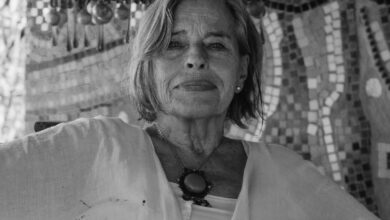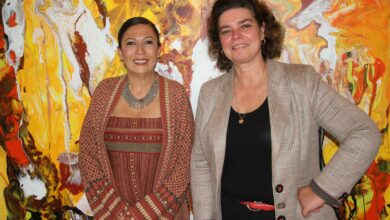On 25 May 2006, Angola launched the Icarus 13, the world’s first space mission to the sun. For two years, 70 laborers, artists and engineers worked relentlessly to build the spacecraft and plan the mission. It landed on the sun at 10 pm. According to the astronauts, “The sun has the most beautiful night.” Proud of their accomplishment, Angolans are planning to launch the first ”solar tourist” flight in 2011 — at least in the imagination of an artist.
The Contemporary Image Collective’s first exhibition in 2011, called Propaganda by Monuments, includes eight photographs documenting the Icarus 13 project. Developed by Angolan artist Kiluanji Kia Hendu in 2008, “Icarus 13” mixes myth with humor as it explores the human quest for greatness. With Africa’s reputation as an underdeveloped continent, Hendu’s work asserts, few believed it could launch a space mission.
The “documentary photographs” which Hendu shot are of state buildings in the Angolan capital, Luanda, built during periods of ambitious plans to modernize the city, when nations sought to manifest their development through grand city structures. To portray the Icarus 13 spacecraft, Hendu shot a photograph of an unfinished mausoleum built for a Russian Socialist leader, which is rumored to contain the remains of the first president of independent Angola. Hendu represents the astronomy observatory with an unfinished colonial era movie theater, and the Icarus 13’s takeoff is shown through a photograph of Angolans celebrating the national team’s qualification for the 2006 World Cup.
“Repurposing things that are so heavy with history is a common practice that this exhibition explores,” explained Mia Jankowicz, co-curator of the show and the artistic director of CiC. The exhibition borrows its title from a short story, “Propaganda by Monuments,” written by the South African writer Ivan Vladislavic in 1996, two years after Nelson Mandela became the first democratically-elected president of South Africa. Reflecting on the turbulent period that followed, Vladislavic recounts fictitious negotiations between a Russian official, his interpreter and a South African businessman, who wishes to import Lenin monuments for use as decorative items in South African bars. Building on the absurdity and plausibility of the proposed use of the Russian monuments, the exhibition, according to its curatorial text, seeks to “confront us with what happens when revolution meets reality and what happens after the revolution ends.”
Despite its timing, Propaganda by Monuments is not a reaction to the 25 January Revolution in Egypt. “It, nevertheless, provides nuance to it,” Jankowicz said. The past few weeks witnessed a plethora of exhibitions on or inspired by the revolution, often showcasing documentary photography and videos from the 18 days of protests. These shows are necessary, said Jankowicz, as “they produce endless revolution conversations.”
Propaganda by Monuments, which was originally scheduled for late January, tries to push such conversations further by examining various historical moments when ideals were refashioned personally or collectively to express modernization, development and liberation, or even through consumer markets and stereotyping. The exhibition was postponed because of the revolution, which gave the artwork a new relevance to the local context.
“Monologue” — a looped video piece by Egyptian artist Ahmed Kamel — contrasts archival video clips of old Egyptian nationalist songs with the audio of contemporary versions, played against a rough monochromatic background. Songs like “Al-Watan al-Akbar” (My Greater Homeland), which expressed pan-Arabism dreams, are reminiscent of the optimism of president Gamal Abdel Nasser's era. Although Nasser’s ambitious plans for industrial development and social equality were unsuccessful, songs of that era continue to stir nostalgic feelings for hopeful times. Since then 11 February ouster of former president Hosni Mubarak, these songs have been continuously played on national television and radio stations.
By also displaying propaganda, the show seeks to highlight how meanings and hopes arising at historical moments are often constructed by association with the past. In Triptych #6, Egyptian artist Imam Issa presents a short conversation she envisions between two co-workers that subtly touches upon social and political conditions in Egypt. Issa shares with her audience the process by which she reached it. Using a photograph of a lake, and the memory it evokes in her, Issa takes a carefully staged picture. From these two images, the final narrative unfolds and by tracing the series, the audience follow her personal process, and perhaps reflect on their own ways of constructing meaning at this critical time.
Propaganda by Monuments runs from 20 March until 23 April 2011 at CiC.
4th floor, 22 Abdel Khalek Tharwat St., Downtown, Cairo
Participating artists: Hasan and Husain Essop, Ângela Ferreira, Dan Halter, Runa Islam, Iman Issa, Ahmed Kamel, and Kiluanji Kia Henda
Project curators: Mia Jankowicz and Clare Butcher
Events program:
Mon 21 March: Screening of Los Angeles Plays Itself, dir. Thom Anderson
Tues 29 March: Opening of Runa Islam's scale (1:16 inch=1 foot) at Factory Space, Townhouse
Sun 17 April: Screening of works by Fernando Sanchez Castillo and David Maljkovic and launch of the publication "Propaganda by Monuments"
Sat 23 April: Screening of works by Eva Bertram




